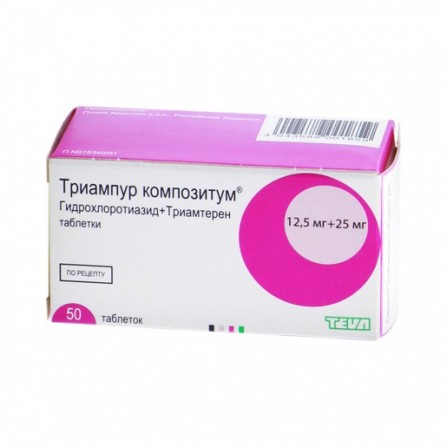Triampur compositum pills 50 pcs
Condition: New product
996 Items
Rating:
Be the first to write a review!

More info
Active ingredients
Hydrochlorothiazide + Triamteren
Release form
Uncoated Tablets
Composition
Active ingredient: Triamterene (Triamterene), Hydrochlorothiazide (Hydrochlorothiazide) Concentration of the active substance (mg): 37.5
Pharmacological effect
Combined medication, the action of which is due to the components in its composition. It has diuretic and hypotensive effects. Hydrochlorothiazide is a medium-acting diuretic. Triamterene is a potassium-sparing diuretic. The combination of these drugs increases the excretion of urine Na +, Cl -, water, bicarbonate, almost without affecting the excretion of K + and Mg2 +. The diuretic effect after 1 h (maximum 2-3 hours) and lasts up to 7-9 hours.
Pharmacokinetics
Data on the pharmacokinetics of the drug is not provided.
Indications
Arterial hypertension; edematous syndrome of various genesis (in chronic heart failure, nephrotic syndrome, liver cirrhosis).
Contraindications
Anuria; chronic renal failure (CC <30 ml / min, serum creatinine more than 1. 8 mg / dL); acute glomerulonephritis; severe abnormal liver function (precoma and hepatic coma); resistant to correction of electrolyte metabolic disorders (hypokalemia, hyperkalemia, hypercalcemia, hyponatremia); hypovolemia; pregnancy; lactation (breastfeeding); hypersensitivity to sulfonamides (due to the danger of allergic cross-reactions).
Precautionary measures
Do not exceed the recommended dose. With caution: diabetes, gout, risk of developing respiratory or metabolic acidosis.
Use during pregnancy and lactation
Contraindicated during lactation.
Dosage and administration
Inside, after eating, not chewing and squeezing a small amount of water. Edematous syndrome: the initial dose is determined by the severity of violations of water and electrolyte metabolism and is usually 1 tablet 2 times a day after meals, then you can increase the dose to the maximum daily (4 pills): 2 pills after breakfast and 2 pills after lunch. When compensating for edema, they switch to maintenance therapy on a 1-2 tablet in 1–2 days. Arterial hypertension: the initial dose is 1 tablet per day (in the morning, after breakfast), then the dose is gradually increased.The maximum daily dose is 4 pills. In patients with impaired renal function (Cl creatinine - 30–50 ml / min), the maximum daily dose is 1 tablet.
Side effects
On the part of the digestive system: nausea, vomiting and sometimes diarrhea (when taking the drug before a meal), pain and discomfort in the epigastric region, colicky abdominal pain, constipation, dry mouth, thirst, in rare cases - hemorrhagic pancreatitis; with cholelithiasis - acute cholecystitis. From the side of the central nervous system: uncoordinated movements, drowsiness, fatigue, headache, nervousness. On the part of the musculoskeletal system: muscle tension, muscle weakness, calf muscle cramps. Since the cardiovascular system: heartbeat, lowering blood pressure, cardiac arrhythmias and circulatory dysregulation with dizziness, stunning consciousness or a tendency to faint. Due to the large loss of fluid and a decrease in the volume of circulating blood during the use of the drug in high doses and abundant excretion of urine, thromboembolism may occur; in rare cases, convulsions, confusion, vascular collapse and acute renal failure. On the part of metabolism: a temporary increase in the blood (mainly at the beginning of treatment) the concentration of nitrogen-containing substances excreted in the urine (urea, creatinine); violations of water and electrolyte balance, mainly a decrease in the content of sodium, magnesium, chlorides in the blood, hypo-or hyperkalemia (with prolonged continuous use of the drug), hypercalcemia, decrease in glucose tolerance. An increase in the uric acid content in the blood is possible, in connection with which some predisposed patients may experience gout attacks and may develop urinary stones. In predisposed patients, depending on the accepted total dose of the drug, an increase in blood lipids may be observed. Due to the increase in glucose concentration in the blood, a latent form may appear or aggravate the already existing diabetes mellitus. The drug can contribute to the accumulation of non-volatile acids in the blood (metabolic acidosis). On the part of the organ of vision: visual impairment, deterioration of existing myopia or a decrease in the production of tear fluid.On the part of the hemopoietic system: aplastic anemia, leukopenia, thrombocytopenia, agranulocytosis, megaloblastic anemia with prior deficiency of folic acid in the body, hemolysis resulting from the appearance in the blood of autoantibodies to the active substance hydrochlorothiazide with simultaneous use of methyldopa. Allergic reactions: reddening of the skin, pruritus, urticaria, systemic lupus erythematosus, photoallergic rash, fever, anaphylactoid reactions, severe inflammation of the blood vessels and non-bacterial inflammation of the kidney tissue (aseptic interstitial nephritis). In isolated cases, suddenly developing pulmonary edema was described. The reason for this is probably the allergic reaction of patients to hydrochlorothiazide. Other: icteric staining of the skin, mucous membranes and sclera.
Overdose
No data.
Interaction with other drugs
Drugs that bind intensively to blood proteins (indirect anticoagulants, clofibrate, NPVHs), are squeezed out of association with protein and increase the diuretic effect. Acute renal failure may develop with the combination with NSAIDs. The antihypertensive effect is enhanced by vasodilators, barbiturates, phenothiazines, tricycins, phenothiazines, and tricycins, phenothiazines, tricycles, phenothiazines, and tricycins, phenothiazines, tricycles, phenothiazines, nitrile tricytes, phenothiazines, zyroxines, barbiturates, phenothiazines, nitrile tricyrs, phenothiazines, and zyroxines, anti-inflammatory drugs, antibiotics, anti-inflammatory drugs, anti-inflammatory drugs, anti-inflammatory drugs. Enhances the neurotoxicity of salicylates, the effects (including side effects) of cardiac glycosides, curariform muscle relaxants, cardiotoxic and neurotoxic effects of lithium preparations. i. Reduces the effects of oral hypoglycemic drugs, norepinephrine, epinephrine and anti-gout drugs; reduces the excretion of quinidine. At the same time taking methyldopa increases the risk of hemolysis. Colestiramine reduces absorption. Chloropropamide can lead to the development of hypokalemia.
special instructions
With prolonged use, it is necessary to control the concentration of K +, Na +, Cl-, urea, creatinine, glucose, uric acid, peripheral blood picture (if folic acid deficiency is suspected) in the blood. At the beginning of drug treatment, you should avoid potentially hazardous activities that require increased attention and the speed of psychomotor reactions (against the background of a decrease in blood pressure - a slower reaction rate).




